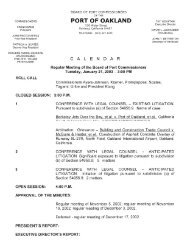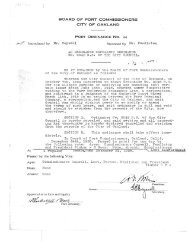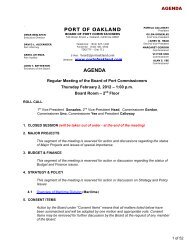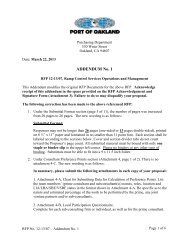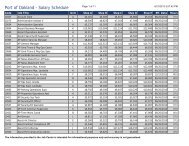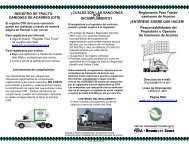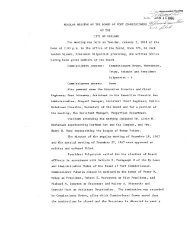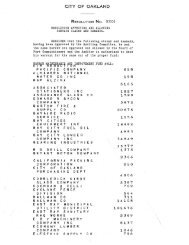Port-Wide Sewer System Management Plan(SSMP) - Port of Oakland
Port-Wide Sewer System Management Plan(SSMP) - Port of Oakland
Port-Wide Sewer System Management Plan(SSMP) - Port of Oakland
Create successful ePaper yourself
Turn your PDF publications into a flip-book with our unique Google optimized e-Paper software.
– Flow Depth for New <strong>Sewer</strong>s. When designing new sewers, it is common<br />
practice to adopt variable flow depth criteria for different pipe sizes. Design d/D<br />
ratios typically range from 0.5 to 0.92, with the lower values used for smaller<br />
pipes, which may experience flow peaks greater than design flow or may<br />
experience blockages from debris, paper or rags.<br />
The maximum d/D ratio under the design flow condition depends on the pipe<br />
diameter as shown in Table 9.1.<br />
Table 9.1 Maximum Allowable d/D Ratio for New <strong>Sewer</strong>s<br />
<strong>Port</strong>-<strong>Wide</strong> <strong>Sewer</strong> <strong>System</strong> <strong>Management</strong> <strong>Plan</strong><br />
<strong>Port</strong> <strong>of</strong> <strong>Oakland</strong><br />
Pipe Diameter<br />
(in.) Maximum d/D Ratio (at Design Flow)<br />
Less than 12 ≤ 0.50<br />
12 to 18 ≤ 0.67<br />
Larger than 18 ≤ 1.00<br />
• Design Velocities and Minimum Slopes. In order to minimize the settlement <strong>of</strong><br />
sewage solids, gravity sewers should be designed for a minimum velocity <strong>of</strong> 2 feet<br />
per second (fps) (based on roughness coefficient <strong>of</strong> 0.013). At this velocity, the sewer<br />
flow will typically provide self-cleaning for the pipe. Table 9.2 lists the recommended<br />
minimum slopes and their corresponding maximum flows for maintaining self-cleaning<br />
velocities (equal to or greater than 2 fps) when the pipe is flowing at its maximum<br />
depth.<br />
• Lift Stations and Force Mains. A minimum <strong>of</strong> two (2) non-clog, submersible pumps<br />
specifically designed for conveying raw wastewater should be installed in each lift<br />
station. If two pumps are to be installed, each should be capable <strong>of</strong> independently<br />
conveying the design flow with the second pump serving as standby. If three or more<br />
pumps are to be installed, the firm capacity <strong>of</strong> the lift station, which is defined as the<br />
total pumping capacity <strong>of</strong> the lift station less the capacity <strong>of</strong> the largest pump, should<br />
be sufficient to convey the design flow.<br />
Force main piping should be sized to provide a minimum velocity <strong>of</strong> 3 fps at the<br />
design flow rate <strong>of</strong> the lift station and no more than 8 fps. For the determination <strong>of</strong><br />
head loss, the Hazen Williams Equation was used with a C factor <strong>of</strong> 100.<br />
May 2010 9-3<br />
pw://Carollo/Documents/Client/CA/<strong>Port</strong> <strong>of</strong> <strong>Oakland</strong>/8239A00/Deliverables/Ch09 (FinalA)



